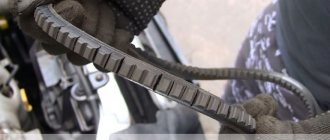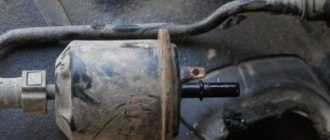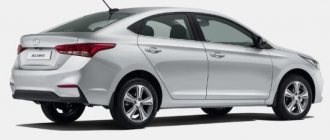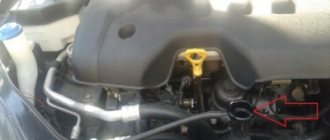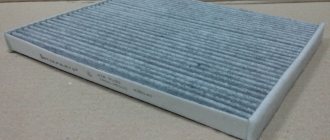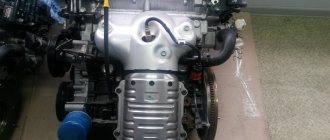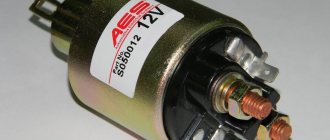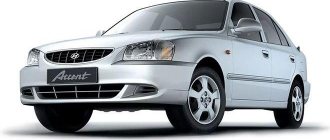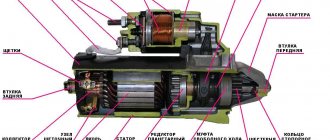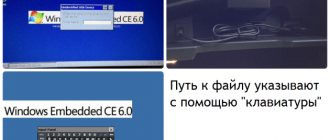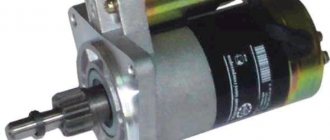The starter (starting device) is designed for the initial rotation of the crankshaft for the purpose of subsequently starting the engine. Minimum starter power 3.0 kW. The jump starter is a source of DC current that draws from the battery.
The battery current is not sufficient to drive the crankshaft. Pre-installed brushes and winding increase the current by 3–4 times.
On cars of the Hyundai Accent family until 2000, starting devices were installed without a gearbox, after the 2000s with a gearbox.
- With gearbox (gearbox): characterized by lower consumption of electrical energy and current. The unit rotates the crankshaft even with a minimum battery charge. However, with prolonged use of the gear starter, breakdowns and malfunctions of the rotation gear are possible.
- Without gearbox: direct acting starter. The design is quite simple, unlike the previous analogue. The part can easily be repaired on your own, without turning to workshops for help. After turning the key in the ignition switch, current is supplied to the electromagnetic switch. Which provides instant grip with the flywheel. This class of starting devices is more durable than gear ones, the probability of breakdown is half lower in comparison with its analogue.
The main disadvantage of a starting device without a gearbox is that it operates unstably at low temperatures.
Problems with the starter, ways to solve them on a Hyundai Accent
Conventionally, all faults are divided into mechanical and electrical according to the nature of their origin.
Mechanical
- Wear of roller bearings;
- Poor fixation of fasteners;
- Deformation, chipping of flywheel teeth;
- Anchor wedge;
- Deformation of the retractor relay;
- Sticking of contacts on the board due to overheating, prolonged start-up of current;
- Reverse spring sag (return);
- Wear of the overrunning clutch, bendix.
Electrical breakdowns
- Loose fit of brushes, wear, chipping;
- Open circuit in the traction relay, the control unit does not turn when current is supplied, the crankshaft does not rotate, the fuel pump does not pump fuel into the system;
- The commutator plates are worn;
- Damage to the armature winding;
- Short circuit on the armature plates;
- Contacts, terminals are oxidized;
- The battery is completely discharged, the car does not start;
- Broken power cable in the area from the steering column to the starting device.
Disassembly
The removed starting unit is disassembled in the following order:
- Using a ratchet with a 13mm head, unscrew the nut connecting the solenoid relay and the starter via the electrical line;
- then use a curved screwdriver to tighten the screws securing the release lever to the motor housing;
- disconnect the traction together with the anchor and spring;
- twist the coupling bolts from the rear cover of the starter - head 8-10;
- remove the screws of the cover securing the brush holder;
- halve the device - disconnect the electric motor with the armature and brush assembly from the front part with the fork, washer, and rubber seal;
- use an open-end wrench to knock down the limit washer and the locking ring on the drive;
- take out the bendix.
Next, part of the electric motor is disassembled. The brush assembly is removed, the armature is separated from the magnetic stator.
Originals, analogues, articles and prices
| Article / name / OEM | Price, rub.) |
| STARTER | |
| BOSCH 0 986 025 720 | From 6200 |
| 0 986 CR1 751 | —/— |
| 0 986 CR1 808 | —/— |
| F 042 200 052 | —/— |
| KAVO PARTS EST-3005 | From 5700 |
| NIPPON PIECES H521I02 | From 5500 |
| VALEO 438098 | —/— |
| —/— 455964 | —/— |
| VALEO 600258 | —/— |
| WAI 17288N | From 6100 |
| SANDO 6035106.0 | From 6400 |
| 6035106.1 (manual transmission) | —/— |
| 6035115.0 (manual transmission) | —/— |
| 6035237.0 | —/— |
| 6035115.1 (automatic transmission) | —/— |
| 6035105.0 (automatic transmission) | —/— |
| Tagaz ES54535 | From 5800 |
| COMPONENTS | |
| Traction relay ERA 227660 | From 650 |
| ERA 227787 | —/— |
| HOFFER 6646057 | —/— |
| 6646127 | —/— |
| MEAT & DORIA 46057 | From 500 |
| —/— 46127 | —/— |
| Carbon brush ERA 233009 | From 150 |
| ERA 233091 | —/— |
| Drive ERA 225181 | From 700 |
| —/— 225240 | —/— |
*check prices at the time of purchase from an authorized dealer.
Factory recommendations
The manufacturer does not recommend repairing the starter yourself, since it believes that this should be done by specialists who are trained in this. Although, it is possible that many garage repair specialists do an excellent job without special training provided by the manufacturer.
Thus, they admit that anyone can repair the Hyundai Accent starter if they wish, if they have the tools and hands. Although, there are situations when it is worth contacting a specialized station, since it is impossible to diagnose the cause of the malfunction and breakdown.
Replacing and installing a starter on a Hyundai Accent
Necessary materials: tools, rags, lubricant, set of heads, components for the starter, gasket repair kit. If natural light is not enough, it is worth installing an additional light source.
- We install the Hyundai Accent on the inspection hole, block the rear row of wheels with shoes, and activate the parking brake. Remove the terminals from the battery;
- Unscrew the nut and remove the power terminals from the starter board. We unscrew the fasteners and remove the PU from the slots.
Subsequent actions depend on the decision: install a new starter or repair the old one. It is cheaper and more rational to restore the old one, but provided that there are no cracks or damage to the body.
DIY repair and dismantling
A Hyundai Accent starter is required to start the engine. It rotates the crankshaft and takes power from the battery. To disconnect the starter and the engine flywheel, a solenoid relay is used. It performs two functions - it supplies power to the starter windings and mechanically connects the gear on the overrunning clutch to the flywheel ring. When operating the starter, you need to follow simple rules - the operation of the device should be short-term, no more than 10-15 seconds. A fully functional injection engine should start in approximately 0.8 seconds. If the startup time is longer, then you need to look for the reason for this behavior.
How to remove the starter Hyundai Accent
To dismantle the starter, you will need keys and sockets for “12”, “13”, and pliers. All work must be carried out from below the car - preferably on an inspection hole or lift. It is imperative to de-energize the power supply system - a positive wire connects to the starter solenoid relay; it does not have protection in the form of a fuse, so a short circuit may cause a fire. Carrying out dismantling:
- Disconnect the negative cable from the battery.
- Using a socket and ratchet, unscrew the starter mount to the clutch block from the top.
- Disconnect the traction relay control wire (thin).
- Slide off the rubber boot that covers the starter power wire.
- Unscrew the nut securing the wire lug.
- Having removed the wire, you can begin to unscrew all the remaining mounting bolts.
- Using the socket “13”, unscrew the lower fastening bolt.
- That's all, now you can remove the Hyundai starter and begin repairing it.
Installation is carried out in reverse order. It is advisable that all important engine components be replaced before installation.
Disassembly and repair
Now you need to completely disassemble the Hyundai Accent starter and replace vital components:
- Brushes - they are worn out when the rotor rotates.
- Bushings - they contain the rotor and also serve as a negative contact for powering its winding.
- If necessary, the solenoid relay must be replaced.
- The Bendix and overrunning clutch are replaced when there is severe wear or failure - the starter does not rotate the engine flywheel.
The procedure for disassembling the starter:
- Disconnect the wire coming from the contact bolt of the traction relay to the stator winding.
- The relay is secured with two bolts - unscrew them with a Phillips screwdriver.
- Carefully remove the anchor, being careful not to lose the spring.
- Proceed to the back cover - unscrew the two bolts that hold the entire body together.
- Using a curved screwdriver, unscrew the brush assembly fastening.
- Remove the back cover and carefully remove the brushes. Assess their condition. In any case, they need to be replaced.
- Remove the spacer washer from the back of the rotor.
- On the front of the starter there is a support and a gear drive lever with an overrunning clutch. Remove them carefully and replace them if necessary.
- Now you can remove the rotor (armature) from the housing.
Be sure to carry out a visual inspection of the rotor - there should be no wear on it. If it is present, then you need to level the surface on a lathe. If the wear is small, you can clean it with fine-grained sandpaper.
Using a multimeter, check whether the rotor windings are shorted to ground. If there is a short circuit, it would be better to replace the rotor or the entire starter. A new one will last 5-10 years with proper use. To remove the overrunning clutch you will need:
- Install the mandrel onto the restrictor ring at the front of the rotor.
- Carefully knock down the ring; there should be a lock underneath it.
- Remove the retaining ring (clamp); you can pry it off with a flat-head screwdriver.
- Remove the restrictor ring and the overrunning clutch with the gear.
After removing this unit, you need to check it - the gear should rotate freely in only one direction. If it rotates in both directions, it needs to be replaced. Be sure to conduct a thorough diagnosis and a thorough inspection - the rotor and other elements should not have damage, cracks, bends, or deformations. When assembling the Hyundai Accent starter, there is no need to use additional lubricant for the components. Try not to damage the Hyundai Accent sensors and their power circuit during repairs. And finally, watch the video about repairing and replacing the Hyundai Accent starter:
Part selection
The original starter for Hyundai Porter 1 costs about 7,700 rubles. It is marked with serial number 3610042050 and is sold in a brown box. The packaging contains a white sticker with a blue edge, the brand logo and an inscription in Korean.
To avoid stumbling upon a fake, carefully examine the box and the part itself: there should be no extraneous logos or inscriptions on them. The starter must be neat, without chips or drips. Check it with photos from the Internet, ask the seller for accompanying documents.
There are several alternative options. You can purchase a similar part if you want to save on replacing components. For example:
- Starters from Bosch. The cost of components varies from 5,500 rubles; original spare parts in the catalog are marked with article number 0986014141, MD191433 and DRS3036N. The manufacturer has a good reputation, positive reviews of the components encourage purchase.
- Krauf brand components are marked with the number SFA2050YJ, the cost starts from 2,700 rubles. A budget option that is not inferior in quality to the original. It will last more than one year.
- ERA starters cost from 5,000 rubles. This is a universal model that fits several different car models. The original can be found under article number 220376. Durable mechanism made of high-quality material.
The choice depends only on your budget and preferences. If you want to be sure of the high quality of the part, then it is better to spend a little more money and order original components.
Starter Hyundai Accent
The starter (starting device) is designed for the initial rotation of the crankshaft for the purpose of subsequently starting the engine. Minimum starter power 3.0 kW. The jump starter is a source of DC current that draws from the battery.
The battery current is not sufficient to drive the crankshaft. Pre-installed brushes and winding increase the current by 3–4 times.
On cars of the Hyundai Accent family until 2000, starting devices were installed without a gearbox, after the 2000s with a gearbox.
- With gearbox (gearbox): characterized by lower consumption of electrical energy and current. The unit rotates the crankshaft even with a minimum battery charge. However, with prolonged use of the gear starter, breakdowns and malfunctions of the rotation gear are possible.
- Without gearbox: direct acting starter. The design is quite simple, unlike the previous analogue. The part can easily be repaired on your own, without turning to workshops for help. After turning the key in the ignition switch, current is supplied to the electromagnetic switch. Which provides instant grip with the flywheel. This class of starting devices is more durable than gear ones, the probability of breakdown is half lower in comparison with its analogue.
The main disadvantage of a starting device without a gearbox is that it operates unstably at low temperatures.
Fuses for Huyndai Porter: decoding the markings of each element
Like most vehicles aimed at the European market, the Huyndai Porter has numbered markings for all fuses in each block, which greatly simplifies the search and replacement of a faulty element. The functional purpose of each fuse can be determined from the data given in the table below.
| Marking of the protective element | Functional purpose of the fuse |
| 1 | The fuse is used to protect interior lights from overvoltage |
| 2 | The fuse controls the operation of the rear brake lights |
| 3 | Reserve element, in some configurations it is used to power the sound signal |
| 4 | The part is required to protect the horn circuit from shorting |
| 5 | The fuse controls the operation of the rear windshield |
| 6 | The element is necessary to protect against overvoltage of reversing lights |
| 7 | The fuse is used to protect the left headlight circuit |
| 8 | The fuse is used to protect the right headlight circuit |
| 9 | The fuse is used to protect decorative lighting in the cabin, if this function is included in the package |
| 10 | A reserve element that is used to unload the circuit of other electrical systems or in case of connecting additional equipment not included in the package |
| 11 | A reserve element that is used to unload the circuit of other electrical systems or in case of connecting additional equipment not included in the package |
| 12 | A reserve element that is used to unload the circuit of other electrical systems or in case of connecting additional equipment not included in the package |
| 13 | The element is responsible for the uninterrupted operation of the cigarette lighter in the cabin |
| 14 | Separate fuse for audio complex and multimedia |
| 15 | The element is responsible for the operation of the windshield and headlight washer and wipers if these functions are included in the configuration |
| 16 | The fuse protects the electric fan of the interior heating system from overvoltage |
| 17 | The module is responsible for the operation of the anti-lock wheel system during braking |
| 18 | The part ensures the operation of all fog lights |
| 19 | The element is necessary for overvoltage protection of direction indicators, as well as hazard warning lights. |
| 20 | This element is responsible for the operation of the chain of the right row of electric windows |
| 21 | This element is responsible for the operation of the circuit of the left row of electric windows |
| 22 | The element is necessary to protect the central locking chain |
Note! Mixed-up fuse markings in any of the blocks are a sign of a makeshift repair, which can result in a short circuit in the vehicle's electrical circuit and cause costly repairs.
If you are inspecting a car before purchasing it on the secondary market or have identified confusing markings after servicing at a service station, then it would not be a bad idea to carry out additional diagnostics of the main electrical circuit.
This is interesting: Colored marks on tires: what do red, yellow, green and white dots mean
